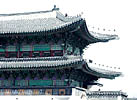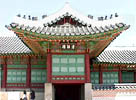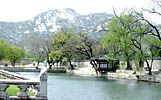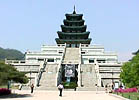 
Gyeongbok Palace |
| Life in Korea rating: 5.0 |
Average member rating: 5.0 (2 ratings) |
|
  Built at the beginning of the Chosun Dynasty when the Yi Dynasty moved the capital to Seoul, this palace remained the main seat of power for Korea kings throughout much of the time to the present. Gyeongbok means Shining Happiness. The main gate (Kwanghwa-mun) separates Gyeongbok Palace from one of the busiest areas of Seoul. Gyeongbok Palace was built as the primary palace of the Chosun Kingdom by its founder, King Taejo in 1395, the fourth year of his reign. Built at the beginning of the Chosun Dynasty when the Yi Dynasty moved the capital to Seoul, this palace remained the main seat of power for Korea kings throughout much of the time to the present. Gyeongbok means Shining Happiness. The main gate (Kwanghwa-mun) separates Gyeongbok Palace from one of the busiest areas of Seoul. Gyeongbok Palace was built as the primary palace of the Chosun Kingdom by its founder, King Taejo in 1395, the fourth year of his reign.
  It was destroyed during the Japanese invasion of 1592 and left in ruins for over 250 years. Starting in 1865, it was rebuilt to its original grandeur. When Korea was annexed by Japan in 1910, most of the 200 building on the palace grounds were torn down by the Japanese, leaving only a dozen structures. The map near the front entrance shows the arrangement of the complex during the latter part of the reign of King Kojong. It shows the major hails, pavilions, offices, storerooms, gates and bridges of the 419,100 square meter grounds. It was destroyed during the Japanese invasion of 1592 and left in ruins for over 250 years. Starting in 1865, it was rebuilt to its original grandeur. When Korea was annexed by Japan in 1910, most of the 200 building on the palace grounds were torn down by the Japanese, leaving only a dozen structures. The map near the front entrance shows the arrangement of the complex during the latter part of the reign of King Kojong. It shows the major hails, pavilions, offices, storerooms, gates and bridges of the 419,100 square meter grounds.
      
Keunjeong-jeon
  In over 600 years, the palace has been severely damaged a number of times. Although only about a dozen buildings remain, at one point the compound housed several hundred buildings. Many have been rebuilt according to their original specifications. Keunjeong-jeon, the royal throne hall is Korea's largest surviving wooden structure. Kings conducted state affairs, held official functions, and received foreign envoys here. Built in 1394, high ranking officials assembled in this court to pay respect to their kings. In over 600 years, the palace has been severely damaged a number of times. Although only about a dozen buildings remain, at one point the compound housed several hundred buildings. Many have been rebuilt according to their original specifications. Keunjeong-jeon, the royal throne hall is Korea's largest surviving wooden structure. Kings conducted state affairs, held official functions, and received foreign envoys here. Built in 1394, high ranking officials assembled in this court to pay respect to their kings.
  From 1399-1549, seven of twelve kings were enthroned here: Chogjong, Sejong, Tanjong, Sejo, Seongjong, Chunjong, and Myongjong. It was burned down during the Japanese invasion in 1592 and rebuilt in 1867, during the reign of King Kojong. The throne is centered toward the back of the hall. There used to be ritual objects there, but none now remain. The building has a high-ceiling, single room structure on a double-level platform. From 1399-1549, seven of twelve kings were enthroned here: Chogjong, Sejong, Tanjong, Sejo, Seongjong, Chunjong, and Myongjong. It was burned down during the Japanese invasion in 1592 and rebuilt in 1867, during the reign of King Kojong. The throne is centered toward the back of the hall. There used to be ritual objects there, but none now remain. The building has a high-ceiling, single room structure on a double-level platform.
  Formerly there were three consecutive gates south of the entrance, between Keunjeong-jon and the city. Keunjeong-mun can be seen in the center of the south corridor. Hongnye-mun was torn down to make way for the capital. Kwanghwa-mun is on the outer wall of the palace, in front of the capital (now bring renovated for the new National Museum). An impressive view of the harmony created between Keunjeong-jon and Pukhan-san (the mountain range directly to the north), can be seen from the second pillar from the east end of the south corridor. Formerly there were three consecutive gates south of the entrance, between Keunjeong-jon and the city. Keunjeong-mun can be seen in the center of the south corridor. Hongnye-mun was torn down to make way for the capital. Kwanghwa-mun is on the outer wall of the palace, in front of the capital (now bring renovated for the new National Museum). An impressive view of the harmony created between Keunjeong-jon and Pukhan-san (the mountain range directly to the north), can be seen from the second pillar from the east end of the south corridor.
    
Chagyong-jeon
  Chagyong-jon was the living quarters for Queen Dowager Cho, the mother of King Honjong (r.1834-1849), the 24th King of the Chosun Dynasty. It was built for her by regent Yi Huang (the Taewongun), father of King Kojong. The present quarters were built in 1888 after the original structure burned down. This is the only building with a bedroom remaining on the palace grounds. The bed chamber is situated to the northwest and is heated by an ondal heating system. The building has a pavilion to the southwest with an elevated floor for use in the summer months. There had been a number of attached buildings, walkways, and a two-post gate with a roof. All that remains is the wall with the symbols of long life and the freestanding chimney in the rear garden, plus a wall with flower and plant designs to the west. Chagyong-jon was the living quarters for Queen Dowager Cho, the mother of King Honjong (r.1834-1849), the 24th King of the Chosun Dynasty. It was built for her by regent Yi Huang (the Taewongun), father of King Kojong. The present quarters were built in 1888 after the original structure burned down. This is the only building with a bedroom remaining on the palace grounds. The bed chamber is situated to the northwest and is heated by an ondal heating system. The building has a pavilion to the southwest with an elevated floor for use in the summer months. There had been a number of attached buildings, walkways, and a two-post gate with a roof. All that remains is the wall with the symbols of long life and the freestanding chimney in the rear garden, plus a wall with flower and plant designs to the west.
Chimney of Chageyong-jeon (Treasure #810)
  The chimney of Chageyong-jeon (designated Treasure #810) forms a part of the wall of the courtyard. It has ten exhausts on the top of the chimney, which is titled to resemble the beams and rafters of a wooden structure. The chimney is decorated with various designs for long life, wealth, and many offsprings, as well as signs to repel evil. On the lower half of the wall is a large decorative panel, the background of which is plaster. It contains a design of the sun, a mountain, water, clouds, a rock, pine tree, turtle, deer, crane, grapes, the fungus of immortality, bamboo, chrysanthemum, and lotus. The chimney of Chageyong-jeon (designated Treasure #810) forms a part of the wall of the courtyard. It has ten exhausts on the top of the chimney, which is titled to resemble the beams and rafters of a wooden structure. The chimney is decorated with various designs for long life, wealth, and many offsprings, as well as signs to repel evil. On the lower half of the wall is a large decorative panel, the background of which is plaster. It contains a design of the sun, a mountain, water, clouds, a rock, pine tree, turtle, deer, crane, grapes, the fungus of immortality, bamboo, chrysanthemum, and lotus.
  Above the panel are three-square designs: a dragon in the center and a crane on either side. Amisan Garden is a terraced garden behind Kyotae-jon, the queen's quarters. Beneath the panel are two square designs of mythological fire-eating beasts, called Haet'ae. On the right and left are a bat and arabesque pattern. The dragon symbolizes the king and the cranes, his subjects. The sun, rock, and turtle stand for longevity; the grapes for many offspring; the bat for wealth; and the Haet'ae for warding off evil and fire. This is one of the most beautiful chimneys remaining from the Chosun era (1392-1910) royal palaces. Above the panel are three-square designs: a dragon in the center and a crane on either side. Amisan Garden is a terraced garden behind Kyotae-jon, the queen's quarters. Beneath the panel are two square designs of mythological fire-eating beasts, called Haet'ae. On the right and left are a bat and arabesque pattern. The dragon symbolizes the king and the cranes, his subjects. The sun, rock, and turtle stand for longevity; the grapes for many offspring; the bat for wealth; and the Haet'ae for warding off evil and fire. This is one of the most beautiful chimneys remaining from the Chosun era (1392-1910) royal palaces.
Hyangwon-jeong
  To the far north on the palace grounds sits Hyangwon-jeong, an attractive hexagonal pavilion surrounded by a lotus pond. When King Kojong had Hyangwon-jeong built in 1867, he had a pond dug to the south of it and the pavilion built on an island in the pond. Hyangwon-jeong was originally connected to the north shore of the pond by a bridge named Ch'wihyang-gyo and the King enjoyed strolling across it to the pavilion. Visitors are not allowed on the bridge or to the pavilion. Instead, they must content themselves with the serene view. This is one of the most painted and photographed places in Korea. To the far north on the palace grounds sits Hyangwon-jeong, an attractive hexagonal pavilion surrounded by a lotus pond. When King Kojong had Hyangwon-jeong built in 1867, he had a pond dug to the south of it and the pavilion built on an island in the pond. Hyangwon-jeong was originally connected to the north shore of the pond by a bridge named Ch'wihyang-gyo and the King enjoyed strolling across it to the pavilion. Visitors are not allowed on the bridge or to the pavilion. Instead, they must content themselves with the serene view. This is one of the most painted and photographed places in Korea.
  Hyangwon-jeong is generally thought to be a two-storied building. However, if one includes the structure below the first floor, it is actually a three-storied building. Its plane is hexagonal and it has railing around it. In 1953, the bridge was rebuilt after the Korean War. This time, the bridge was constructed to reach the south shore of the pond. Originally there was a wall to the East of the pond with a double gate to the south, making it more private and secluded. Hyangwon-jeong is generally thought to be a two-storied building. However, if one includes the structure below the first floor, it is actually a three-storied building. Its plane is hexagonal and it has railing around it. In 1953, the bridge was rebuilt after the Korean War. This time, the bridge was constructed to reach the south shore of the pond. Originally there was a wall to the East of the pond with a double gate to the south, making it more private and secluded.
     
Yolsang Chinwon Spring
This spring was here when the palace was built in 1395. Its water is so pure and cold that it is good for drinking. It also flows into the adjacent Hyangwon-ji (far-reaching fragrance) pond. The stone trough was specially designed to supply water to the pond without disturbing the reflection of the pavilion and trees. The waterway makes two turns at right angles to ensure that the water flow remains consistently slow.
Kyeonghoe-ru
  Kyeonghoe-ru is the largest pavilion in South Korea and has been designated National Treasure #224. Supported by 48 stone pillars and set in a lotus pond, the pavilion was a favored place for the King to entertain visiting dignitaries. King Taejo, founder of the Chosun Dynasty and builder of Gyeongbok Palace, had the pavilion erected on this man-made lake in the western section of the palace. He named Kyeonghoe for "joyous meeting." Kyeonghoe-ru is the largest pavilion in South Korea and has been designated National Treasure #224. Supported by 48 stone pillars and set in a lotus pond, the pavilion was a favored place for the King to entertain visiting dignitaries. King Taejo, founder of the Chosun Dynasty and builder of Gyeongbok Palace, had the pavilion erected on this man-made lake in the western section of the palace. He named Kyeonghoe for "joyous meeting."
  King Daejeong (r.1401-1408) ordered his Minister of Manufacturing and Construction (Pak Cha-chong) to enlarge both the lake and the structure. Minister Park built a square with dragon-shaped island supported by a long stone on which to construct the larger pavilion. Forty-eight stone pillars, sculptured with dragons, supported the second floor. Two more islets were made in the lake. King Daejeong (r.1401-1408) ordered his Minister of Manufacturing and Construction (Pak Cha-chong) to enlarge both the lake and the structure. Minister Park built a square with dragon-shaped island supported by a long stone on which to construct the larger pavilion. Forty-eight stone pillars, sculptured with dragons, supported the second floor. Two more islets were made in the lake.
  During the Japanese invasion in 1592, the original Kyeonghoe-ru was burned down leaving only the stone supports. When Gyeongbok palace was rebuilt in 1867, the fourth year of the reign of King Kojong the pavilion was reconstructed. The pillars were replaced with new ones that lack the splendor of the former. But animals were carried on the stone brides and railings. There are such stone structures as the Lotus Pond, Lotus Platform, and dragon-shaped conduits along the lake. This pavilion was used for royal banquets during the Chosun period and is used today for special functions. During the Japanese invasion in 1592, the original Kyeonghoe-ru was burned down leaving only the stone supports. When Gyeongbok palace was rebuilt in 1867, the fourth year of the reign of King Kojong the pavilion was reconstructed. The pillars were replaced with new ones that lack the splendor of the former. But animals were carried on the stone brides and railings. There are such stone structures as the Lotus Pond, Lotus Platform, and dragon-shaped conduits along the lake. This pavilion was used for royal banquets during the Chosun period and is used today for special functions.
  
  National Folk Museum National Folk Museum
The National Folk Museum sits in the northern section of the palace. The museum has several exhibition halls which periodically change their exhibits, showing a wide selection of Korean culture and history. The building housing the former National Museum of Korea (built by the Japanese during the Japanese occupation) has been demolished and its historical treasures await a new home in Yongsan Family Park.
Hours:
Mar. ~ Oct. - 09:00 ~ 18:00 (May ~ Aug. Saturdays/Sundays/Holidays: closing time extended 1 hour)
Nov. ~ Feb. - 09:00 ~ 17:00
Admission:
Adults (19 to 64 years old): 3,000 won (groups: 2,400 won)
Children (7 to 18 years old): 1,500 won (groups: 1,200 won)
* Children 6 and under, seniors 65 and over: Free
Directions:
Subway line 3, Gyeongbokgung Station, exit 5; Subway line 5, Gwanghwamun Station, exit 2
(For more sites of Gyeongbok Palace, please see page 2.)
See related tour(s). |
|
Member Comments:
[anonymous] (Rating: 5)
Date: January 5, 2011
Very Nice
hanbohyang- (Rating: 5)
Date: March 8, 2003
This is a very beautiful palace!! i recommend visiting this, it is a must-see. there is a lot of history and fun things to look at. it is a very popular wedding picture and school-trip destination. Watch out for all the brides and the school children during the day!! It is my favorite palace in korea. there are many picture opportunities so remember your camera!
Rate this destination
|
Transportation:
Bus: 23 (Ui-dong - I'taewon), 135, 135-1, 135-2 (Shinchon - Seoul Station - Puam-dong), 740 (Mok-dong/Immigration Office - downtown) Subways: Gyeongbokgung (Gyeongbok Palace)- Seoul Line 3 (orange)
|
|
|

|
|

























